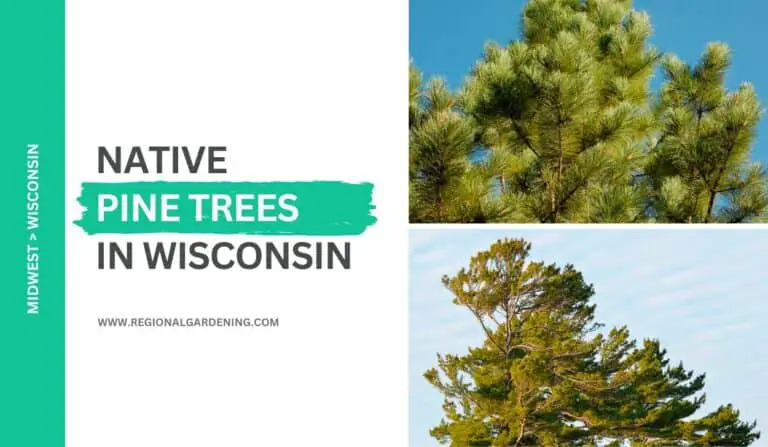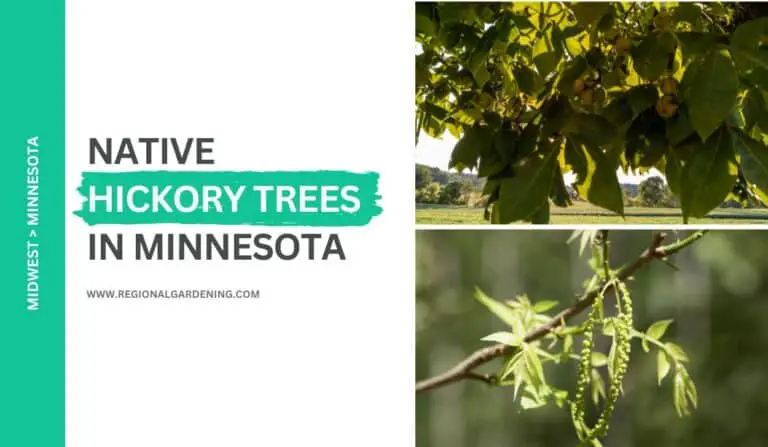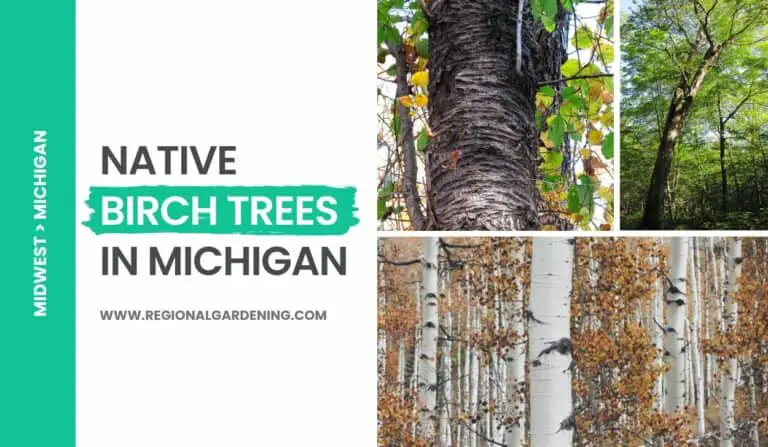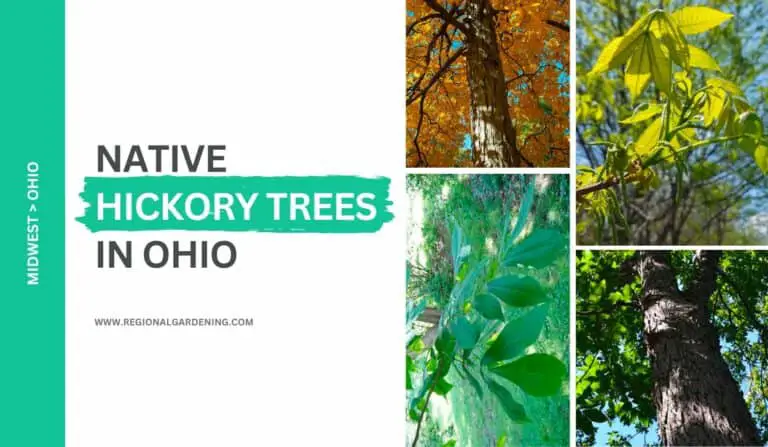4 Native Maple Trees In Wisconsin (Photos, Care & Identification)
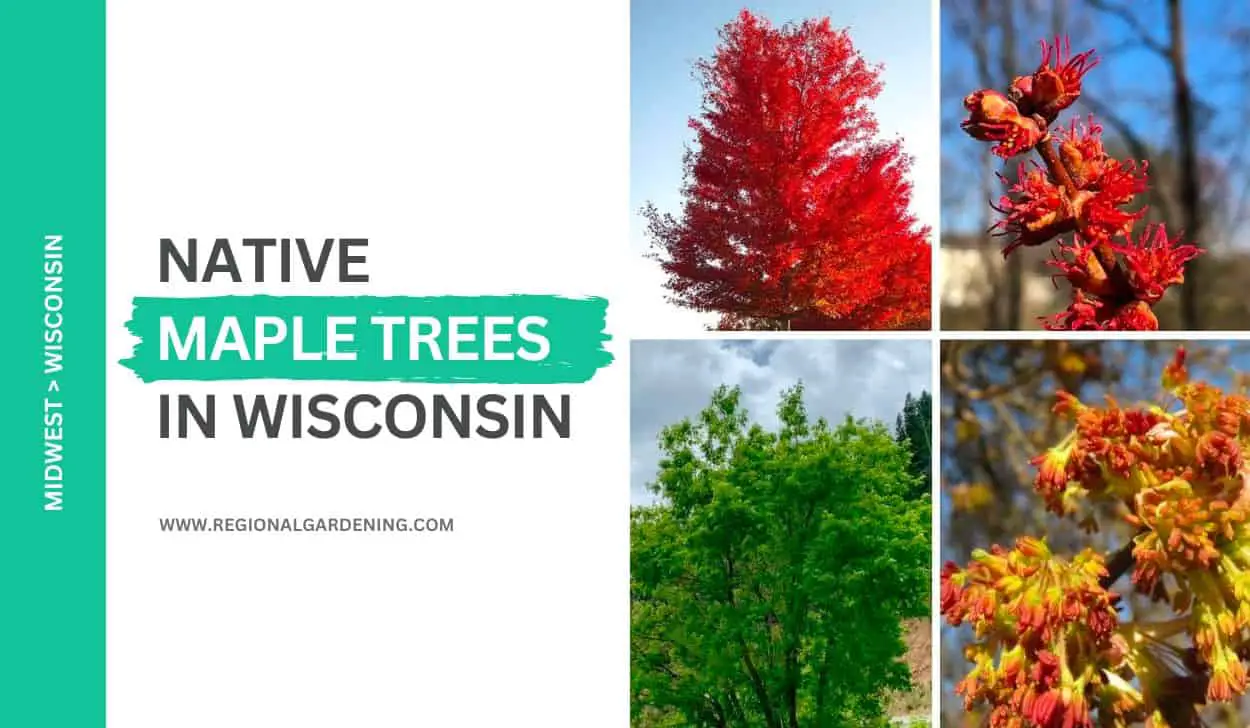
Sugar maples are one of the most commonly found trees in the entire North American subcontinent.
According to FDA reports for 2022, Wisconsin produced approximately 440,000 gallons of maple syrup, which means that the state also has a vibrant population of sugar maple trees.
But do you know that Wisconsin is also home to three other maple varieties?
Well, in this article, I’ll walk you through the 4 types of native maple trees in Wisconsin, along with a high-quality photo and detailed descriptions.
So, let’s get started.
1. Sugar Maple
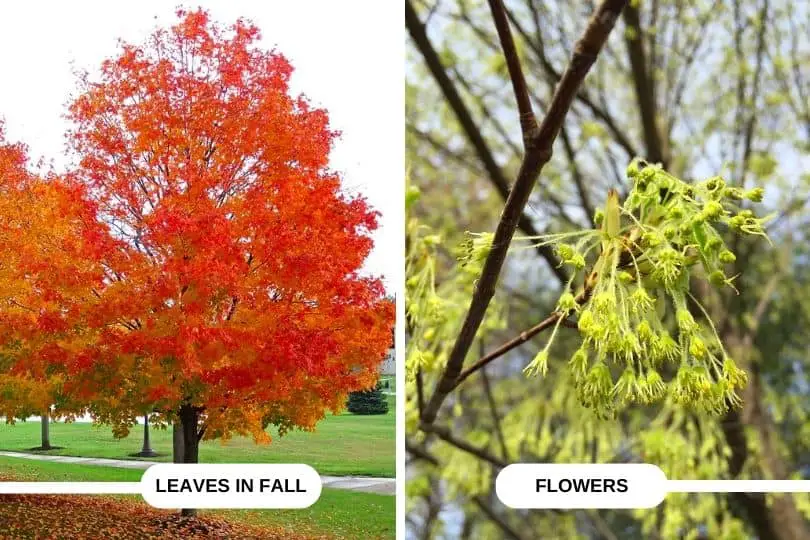
- Common Name: Silver Maple
- Scientific Name: Acer saccharinum
- Mature Height: up to 100 feet
- Native/Non-Native: Native
- Flowers/Cones: Produces winged seeds called samaras
- Uses: Popular as a shade tree and occasionally used for flooring, furniture, and fuel
Among the native maple trees in Wisconsin, the Sugar Maple is the most common and useful one. It is a majestic tree that can reach a height of 100 feet and a diameter of 2 to 3 feet. The tree has a large, spherical crown with a symmetrical shape.
The bark of young trees is light gray to brown and somewhat smooth. The bark of elder trees is dark to virtually black, with lengthy, uneven plates or scales that frequently loosen on the edges. The twigs are reddish-brown and smooth, with sharp-pointed winter buds.
Sugar Maple leaves are opposite, 3 to 5 inches long, and frequently five-lobed. The lobes are serrated and wavy. The leaves are dark green on top and paler green on the bottom. The leaves turn gorgeous colors of yellow, orange, and red in the autumn, making it one of the most beautiful trees in the forest.
The Sugar Maple produces a pair of fused samaras about 1 inch long in the fall. These samaras serve as wings for the seeds, allowing them to spread in the wind.
The Sugar Maple can be found on superior soils throughout the state. It has light brown wood that is durable, hefty, sturdy and close-grained. Commercially, the tree is known as hard or rock maple. It is utilized in the production of flooring, furniture, and maple syrup. The tree is also employed as a fuel source.
2. Red Maple

- Common Name: Red Maple
- Scientific Name: Acer rubrum
- Mature Height: 40 to 65 feet
- Native/Non-Native: Native to North America
- Flowers/Cones: Produces samaras, also known as helicopter seeds
- Uses: Used in furniture manufacturing, woodenware, and fuel; also an important ornamental tree
The Red Maple, also known as Acer rubrum, is a tree that can reach 65 feet in height and has a narrow, rounded crown. When young, the bark is smooth and light gray, but as it ages, it becomes dark gray and rough. Shallow fissures near the surface of the old bark separate it into flat, scaly ridges, giving the tree a shaggy appearance.
Red Maple leaves are opposite, 2 to 5 inches long, with 3 to 5 lobes and double-toothed margins. When mature, the upper surface is bright green, while the under surface is whitish and partly covered with pale down. Winter buds are tiny, scarlet, and spherical.
On long, drooping stems, the Red Maple produces samaras measuring 1/2 to 1 inch in length. They are crimson, reddish-brown, or golden when ripe and germinate instantly. The tree favors damp soils but can also be found in dry areas combined with other trees.
The Red Maple’s wood is heavy, close-grained, weak, and light brown. It is used in the production of furniture, and woodenware, and as fuel.
The Red Maple is an important ornamental tree due to its shape and stunning foliage colors. It is indigenous to North America and can be found throughout the continent. Its samaras, or helicopter seeds, make it an interesting tree to study and observe.
Being one of the medium-height maple trees in Wisconsin, the Red Maple is an important species in our natural environment, whether for its beauty or for the benefits its wood gives.
3. Silver Maple
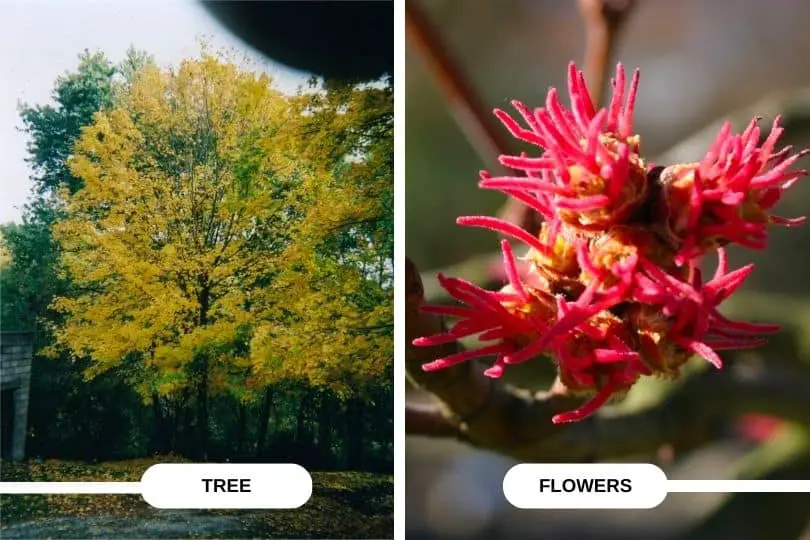
- Common Name: Sugar Maple
- Scientific Name: Acer saccharum
- Mature Height: 80 to 100 feet or more, diameter 2 to 3 feet
- Native/Non-Native: Native to North America
- Flowers/Cones: The Sugar Maple produces small yellow-green flowers in the spring.
- Uses: Flooring, furniture, and maple syrup
One of the most commonly found maple trees in Wisconsin, the Silver Maple, scientifically known as Acer saccharinum, is a majestic tree with a trunk diameter of more than 3 feet and a towering height of up to 100 feet.
It is native to various regions of North America and is a common tree in the southern two-thirds of the United States on river bottoms or other deep, moist soils.
The Silver Maple’s bark is one of its distinguishing characteristics; it is smooth and varies in color from reddish to yellowish-gray on young trees or branches, and dark gray and broken into long flakes or scales on older branches.
The opposing leaves have three to five lobes that end in long points separated by deep, angular holes. The leaf margins are serrated, with a pale green upper surface and a silvery underside. The buds are spherical and reddish-brown.
The tree produces winged seeds called samaras, which are paired and have one to two-inch long wings. Samaras mature in the spring and germinate almost immediately. The Silver Maple’s wood is light-brown, robust, and reasonably durable, with an even grain that is fragile and easily handled.
However, when exposed to weather or soil, it decays quickly, therefore it is frequently blended with red maple for commercial purposes. While it is sometimes used for flooring, furniture, and fuel, it is most commonly employed as a shade tree.
If you have a Silver Maple in your garden or neighborhood, remember that its branches are prone to breaking in storms, so be cautious where you park your car or set up your picnic table. Nonetheless, this is a beautiful tree that provides shade, shelter, and habitat for a variety of creatures and is an important part of our ecosystem.
4. Boxelder Maple
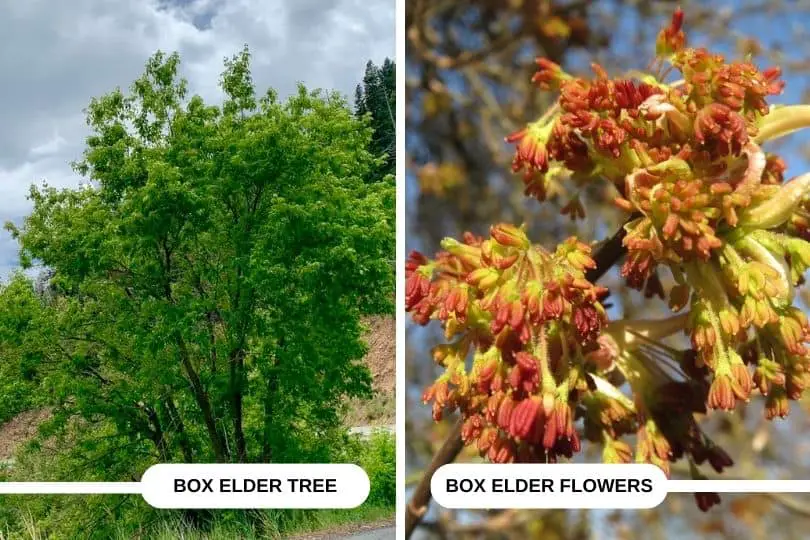
- Common Name: Box Elder
- Scientific Name: Acer negundo
- Mature Height: 30 to 50 feet
- Native/Non-Native: Native
- Flowers/Cones: Samara fruit hanging in clusters
- Uses: occasionally used for fuel
One of the shortest maple trees in Wisconsin, the Box Elder is a widespread tree in the United States. This tree can grow to be 30 to 50 feet tall and up to 18 inches in diameter. It’s a fast-growing tree that’s common along streams and chilly ravines.
The Box Elder has an unusual appearance, with an asymmetrical and open crown. Because its branches and limbs are relatively frail, it is sensitive to high winds. On young branches, the bark is smooth and green to purple, but as the tree becomes older, it becomes grayish to light brown and highly split.
The Box Elder has complex leaves that range in length from five to eight inches. Each leaf has three leaflets, although it can also have five. These shiny green leaves range in size from two to four inches long and one to two inches wide. They give the tree a lovely appearance, especially in the fall when the leaves change to yellow and gold.
The Box Elder’s fruit is a samara, which hangs in clusters. The samara has two wings and is similar to, but smaller than, the sugar maple. The fruit ripens in late summer or early fall and frequently remains on the tree throughout the winter.
Although the Box Elder is not used commercially, it is occasionally used as fuel. The wood is creamy white, soft, light, and close-grained, but when exposed to heat and moisture, it decays quickly.
Despite its low commercial value, the Box Elder has a vital ecological role by providing refuge and food for species like birds, butterflies, and bees.
Native Maple Trees In Wisconsin – Frequently Asked Questions (FAQs)
This section contains some of the most frequently asked questions on the internet about maple trees in Wisconsin.
What kind of maple trees grow in Wisconsin?
Several maple tree species can be found in Wisconsin. Sugar maple (Acer saccharum), red maple (Acer rubrum), silver maple (Acer saccharinum), and boxelder maple are the most common maple trees in Wisconsin.
Wisconsin’s state tree is the sugar maple, which is known for its vibrant fall foliage and valuable sap used in maple syrup production. Red maples, with their brilliant red autumn leaves, are also widespread. Silver maples and boxelder maples, though less common, can also be found throughout the state. The presence of these maple tree species enhances the natural beauty of Wisconsin’s forests, parks, and landscapes.
What are the uses of maple trees in Wisconsin?
One of the primary uses of maple trees in Wisconsin is the production of maple syrup, as Wisconsin is a significant producer of this sweet delicacy with more than 440,000 gallons of in 2022. The sap from maple trees, primarily sugar maples, is collected and boiled down to produce maple syrup and other maple products.
Furthermore, maple wood is highly valued for its strength, fine grain, and aesthetically pleasing appearance. It is commonly used in the construction of furniture, flooring, cabinetry, and other woodworking projects. Maple trees also provide shade, contribute to the overall aesthetic of landscapes, and provide habitat and food sources for wildlife. Also, maple trees are prized for their vibrant autumn foliage, making them an important part of Wisconsin’s seasonal beauty.
Similar Articles
- Native Oak Trees In Wisconsin
- Native Ash Trees In Wisconsin
- Native Pine Trees In Wisconsin
- Native Aspen Trees In Wisconsin
- Native Spruce Trees In Wisconsin
- Native Cedar Trees In Wisconsin
- Native Birch Trees In Wisconsin
- Native Elm Trees In Wisconsin
- Native Hickory Trees In Wisconsin
- Native Locust Trees In Wisconsin
- Native Cherry Trees In Wisconsin
- Native Nut Trees In Wisconsin
Sources
The Regional Gardening team makes sure that the information in our articles is accurate by only using sources that are known to be trustworthy. Some of these sources are peer-reviewed journals from government agencies, well-known universities, and scientific research organizations.
- Tree Planting, Wisconsin Department Of Natural Resources
- Trees Identification, Wisconsin Department Of Natural Resources
- Forest Trees Of Wisconsin, Wisconsin Department Of Natural Resources
- Trees of Wisconsin Field Guide, Book by Stan Tekiela


